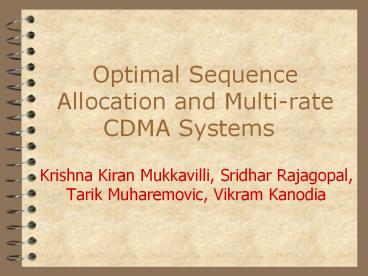Optimal Sequence Allocation and Multi-rate CDMA Systems - PowerPoint PPT Presentation
Title:
Optimal Sequence Allocation and Multi-rate CDMA Systems
Description:
... CDMA multiuser system. Discussion ... Performance of multiuser detectors. Interference avoidance ... Interference Avoidance in Wireless Multiuser Systems ... – PowerPoint PPT presentation
Number of Views:32
Avg rating:3.0/5.0
Title: Optimal Sequence Allocation and Multi-rate CDMA Systems
1
Optimal Sequence Allocation and Multi-rate CDMA
Systems
- Krishna Kiran Mukkavilli, Sridhar Rajagopal,
Tarik Muharemovic, Vikram Kanodia
2
Motivation
- 3rd Generation Comm. Systems
- Multimedia(Data, Voice, Video)
- Multiple Rate Comm.
- Multi-Rate Detection
- Users entering/leaving the system
- Optimal Sequence Allocation to achieve Capacity.
3
Outline
- Conventional CDMA multiuser system
- Discussion of multirate systems
- Methods of multirate CDMA access
- Performance of multiuser detectors
- Interference avoidance
- Application to variable number of users
4
Multi-rate CDMA systems
- Multi code access (MC)
- Give more Codes
- Variable spreading length (VSL)
- Change Spreading Length
- Variable chip rate(VCR)
- Change Chip Frequency
5
Multi code (MC)
- Higher Rate users assigned more codes
- Data transmitted in parallel
- Virtual User Concept
- Same Spreading for all users.
6
Multi Code
Code 1
Code 2
User Rate R
User Rate 2R
T
Code 3
7
Variable spreading length(VSL)
- Higher Rate Users allocated smaller spreading
lengths - For detection, rate of slowest user is
considered. - More bits of higher rate users detected per bit
of lower rate users - For detection, put 0s
8
Variable Spreading Length
User Rate R
T
User Rate 2R
2T
9
Variable Chip Rate(VCR)
- User allocated different chip rates
- Larger Bandwidth required
- Requires more RF hardware
- Oscillators
- Not practical for implementation
10
Variable Chip Rate
User Rate R
T
User Rate 2R
2T
11
Implementation Aspects
- VSL and VCR have a sparse correlation matrix
- VCR requires larger bandwidth
- MC requires more codes
- VSL proposed for next generation systems
12
Multiuser Detectors
- Maximum likelihood detector (MLD)
- Conventional single user detector (SUD)
- MMSE detector
- Decorrelating detector
13
Simulations
- Four users
- 2 users at rate R
- 2 users at rate 2R
- Random Codes
- Spread length 32 for low rate user
- 10000 bits
- Channels
- AWGN
- Fading - Jakes Model
14
Investigate...
- Performance of multiuser detectors
- Near far problem in detectors
- Performance of high rate and low rate users in MC
and VSL systems - All users with equal power
- Users with unequal power
15
BER comparison for different detectors in multi
code system
0
10
MLD
MMSE
Decorrelator
Single user detector
-1
10
-2
10
BER
-3
10
-4
10
2
3
4
5
6
7
8
9
10
11
12
SNR
16
BER comparison for detectors with unequal powers
0
10
MLD Equal Power
MLD Unequal Power
SUD Equal Power
SUD Unequal Power
-1
10
-2
10
BER
-3
10
-4
10
2
3
4
5
6
7
8
9
10
11
12
SNR
17
Comparison of Different Rate Users in MC and VSL
0
10
High rate MC
High rate VSL
Low rate MC
Low rate VSL
-1
10
-2
10
BER
-3
10
-4
10
2
3
4
5
6
7
8
9
10
11
12
SNR
18
VSL System
- Virtual user from high rate user
- lower spreading length
- lower interference (other virtual users are
orthogonal) - High rate user
- interference from same number of virtual users
with lower spread length
19
Variable Spreading Length
User Rate R
T
User Rate 2R
2T
20
Near Far effect for Different Rate Users in MC
and VSL
0
10
Low rate MC
Low rate VSL
High rate MC
High rate VSL
-1
10
-2
10
BER
-3
10
-4
10
2
3
4
5
6
7
8
9
10
11
12
SNR
21
Results
- Multi Code
- High rate and low rate users have same
performance (both BER and NFR) - VSL
- Low rate users have bad BER and NFR
- High rate users performance is similar to
multicode access system.
22
Interference Avoidance in Wireless Multiuser
Systems
- Interference Avoidance ? send where there is less
noise - Fixed modulation - traditional approach
- TDMA
- FDMA
- CDMA
- CWMA
- Future wireless systems - dynamically adapt to
the changing interference pattern
23
Preliminaries for Multiuser Systems
(class notes pg. 5-12)
- System model
- Capacity region
24
Total Square Correlation vs Iteration Number
9.5
Total Square Correlation
Optimum Lower Bound
9
8.5
Total Square Correlation
8
7.5
7
1
1.5
2
2.5
3
3.5
4
4.5
5
5.5
6
Iteration Number
25
Preliminaries for Multiuser Systems
(class notes pg. 5-12)
- Sum Capacity
- W channel bandwidth
- Pi power of i-th user
- N0 noise power spectrum
26
Multiuser Spread Spectrum Systems
- System model
27
Multiuser Spread Spectrum Systems
- Sum Capacity
- Optimum sequences maximize Sum Capacity
- Total Square Correlation (TSC)
- Max. Sum Capacity ? Min. TSC
28
Eigen-Algorithm
- Iterative reduction of TSC
- User k updates his spreading sequence
- Rayleigh quotient
- Choose sk to be eigenvector with smallest
eigenvalue
29
Performance comparison of optimal codes with
random codes
0
10
Random Code Allocation
Optimal Code Allocation
-1
10
-2
10
BER
-3
10
-4
10
8
10
12
14
16
18
20
22
SNR
30
BER Performance with an Incoming User
0
10
Random Code to new user
Iteration for new user only
Optimal Code Allocation
-1
10
BER
-2
10
-3
10
6
7
8
9
10
11
12
13
14
15
16
SNR
31
Conclusions
- Significant improvement in performance with
optimal codes - Iterative algorithm compatible with user dynamics
- Good sub-optimal schemes for user addition
- Can be combined with the multi-rate schemes































